Sights of Kursk
Around Red Square
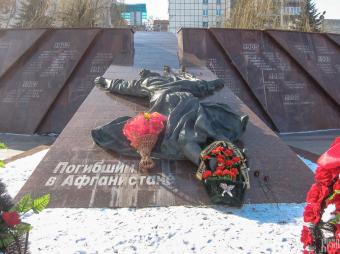
Afghan War Memorial
- in park at the intersection of Ulitsa Dzerzhinskogo and Ulitsa Verkhnyaya Lugovaya
Like most cities, Kursk has a memorial to its sons who were killed in the Soviet-Afghan War of December 1979 to February 1989. Whereas most Soviet war memorials to the Second World War are rather bombastic and focus on the victory, Afghan war memorials tend to be more poignant and focus on the loss of human life. The memorial in Kursk is no exception; it depicts a mother lying face down on the floor and weeping. Read more »
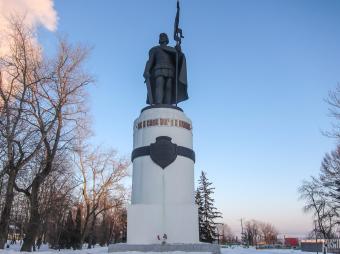
Aleksandr Nevsky Monument
- Krasnaya Ploschad (Park imeni 1 Maya)
Located at one of the entrances to Park imeni 1 Maya (1st May Park) is a monument to the 13th century grand prince Aleksandr Nevsky, one of Russia's most beloved heroes. The monument was unveiled in 2000. It was a gift to the city from its sculptor Vyacheslav Klykov, himself from the Kursk Region, and is just one of several monuments by the sculptor in the city. It depicts Nevsky with a sword in one hand and a banner in the other. Read more »

House of Officers (Planetarium)
- 4 Ulitsa Sonina
- http://kursk-museum.ru/index.php/menuplanet.html
- 09:00 - 17:00 (12:00 - 14:00 for individual visitors). Closed on Sundays.
One of the grandest buildings in Kursk is the House of Officers which is a red building with beautifully elaborate white carved window frames and decorative features. It was built in 1877 but heavily damaged during the Nazi occupation of Kursk and subsequently rebuilt. Since 1994 the House of Officers has been home to the city's planetarium which was founded in 1956. Read more »
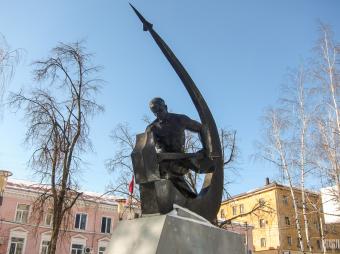
Let's Beat Swords into Ploughshares Sculpture
- intercession of Ulitsa Radischeva and Ulitsa Dzerzhinskogo
An excellent example of a Soviet-style sculpture is the Let's Beat Swords into Ploughshares Sculpture. Its shows an idealised Soviet worker beating a sword with an oversized hammer on an anvil in the form of a sickle, so that in whole the sculpture represents a giant hammer and sickle. At the tip of the sickle there is a space rocket, symbolising the importance of space exploration over war. Read more »
Our Lady of the Kursk Root Icon Monument
- opposite 4 Ulitsa Sonina
This monument depicting a giant version of the Our Lady of the Kursk Root Icon was unveiled in 1996 to mark the 700th anniversary of the appearance of the icon. According to legend the icon was found in the root of a tree near Kursk. The icon was later held in the city until it was taken abroad after the revolution, where it remains today. The monument is the work of sculptor Vyacheslav Klykov, himself from the Kursk Region. Read more »
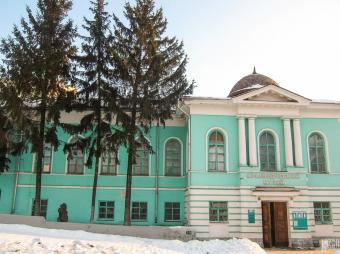
Regional Museum of the Kursk Region
- 6 Ulitsa Lunacharskogo
- http://kursk-museum.ru
- 10:30 - 17:00. Closed on Fridays and the last Thursday of the month.
Located in what was once the bishop's chambers is the Kursk Region Regional Museum. It was founded in 1903 and now holds over 180,000 exhibits. The museum is mostly concentrated on the history of the Kursk lands starting from ancient times right up to the Soviet period and modern times. In addition the museum has a department devoted to the nature of Kursk lands. Read more »
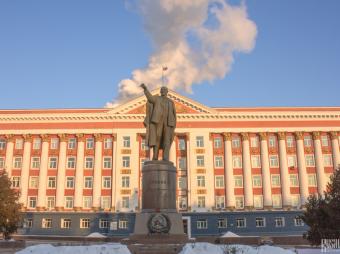
Vladimir Lenin Monument
- outside 18 Krasnaya Ploschad (Red Square)
A statue of Vladimir Lenin stands on Kursk’s Red Square in front of the pretty Soviet-style city administration building. An statue of Lenin was installed here in 1933, but this was destroyed in the Second World War. The present statue was unveiled in 1956 and is the work of the celebrated sculptor Matvey Manizer. It depicts Lenin in a standard pose with an outstretched arm and with a long coat resting on his shoulders. Read more »
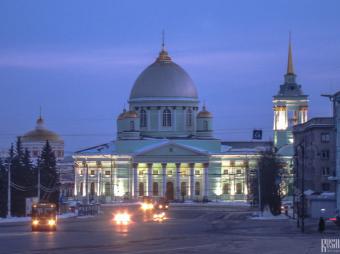
Znamensky Monastery
- 4 Ulitsa Lunacharskogo, Krasnaya Ploschad (Red Square)
The Znamensky Monastery was founded in 1612 after the Polish siege of Kursk was lifted and its defenders set about fulfilling their pledge to build a monastery should the Virgin Mary save them. Originally the monastery was dedicated to the Nativity of the Virgin Mary, but from 1618 the monastery was rededicated to the Our Lady of the Sign Icon (Znamenie) as the Our Lady of the Kursk Root Icon was housed there. In the mid-17th century the monastery's churches were replaced with… Read more »
Around the Centre
Aleksandr Deyneka Art Gallery
- 85 Ulitsa Radischeva
- http://deinekagallery.ru
- 10:00 - 17:00. Closed on Mondays.
Kursk's art gallery is named after the artist and sculptor Aleksandr Deyneka who was born in Kursk in 1899 and is famous for his mosaics at Moscow's Mayakovskaya Metro among other works. Previously the gallery was located in the St Sergius of Radonezh and Our Lady of Kazan Icon Eparchial Cathedral. Today the gallery displays work from both Western Europe and Russia as well as ancient icons. It also has a department dedicated to art of the Soviet Union which contains many examples… Read more »
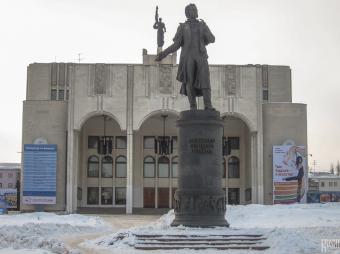
Aleskandr Pushkin Monument and Drama Theatre
- 26 Ulitsa Lenina
Like many Russian cities, Kursk has a statue of Aleksandr Pushkin, Russia's most celebrated poet. It was unveiled in 2000 as part of the bicentenary celebrations of the poet and stands outside the Kursk Drama Theatre which is named after Aleksandr Pushkin. The theatre's building dates from 1983 and features a statue of Nike, the Greek goddess of victory, on the top. Read more »
Ascension Church
- 131 Ulitsa Verkhnyaya Kazatskaya
Located in the area historically known as Kazatskaya Sloboda (Cossack's Settlement) is the pretty Ascension Church. It was built in the classical style between 1887 and 1888 and was the dominate feature of the settlement. The main part of the church has five domes standing on octagonal tholobates. The front of the church comprises a four-tier bell tower and a pediment supported by columns. The church was closed in 1940 but shortly afterwards reopened and then remained open. Read more »
Assumption of Virgin Mary Catholic Church
- 31 Ulitsa Marata
- http://www.uspenie.kursk.ru
Kursk's catholic church, which is dedicated to the Assumption of the Virgin Mary was built between 1892 and 1896 using the funds of the city's relatively small Catholic community who had been petitioning for permission to build a church since the mid-19th century. The famous artist Kazimir Malevich was married in this church as he was living in Kursk at the time. The church was closed in 1938 and since 1970 was used as a House of Culture. It was only returned to the Catholic Church… Read more »
Kursk Antonovka Apple monument
- outside 11 Ulitsa Lenina
This unusual monument is dedicated to the Kursk Antonovka variety of apples and consists of a two metre high apple weighing 150 kilos and with a diameter of one and a half metres. The Kursk Antonovka is an apple cultivar which is popular in Russia which was first cultivated in the Kursk Governorate in the 19th century. This monument is by the famous sculptor Vyacheslav Klykov. It was unveiled in 2004 and is one of the last monuments of the sculptor who died in 2006. Read more »
Kursk Region Museum of Archaeology (Boyar Romodanovsky's Chambers)
- 6 Ulitsa Pionerov
- http://archeo-kursk.narod2.ru
- 09:30 - 17:00. Daily.
The Kursk Region Museum of Archaeology was founded in 1991. The museum was originally located in the Trinity Church until 1993 when it moved to its present location in the building known as Boyar Romodanovsky's Chambers. A legend exists that Stepan Razin was imprisoned here in 1671, but experts believe the house dates from the mid-18th century at the earliest. The museum's exhibits include examples of tools, ornaments, jewellery coins and weapons found in archaeological digs. Read more »
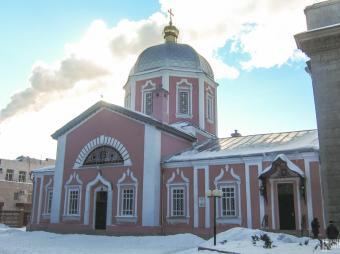
St Elijah the Prophet and Resurrection Church
- 11 Ulitsa Lenina
This church, dedicated both to St Elijah the Prophet and the Resurrection of Christ was completed in 1768 replacing an earlier wooden version. In form it is the standard octagon-on-cube design with a single large dome. In 1926 the church was closed and subsequently used as an archive. In the 1950s its bell tower was demolished. It was returned to the Orthodox Church in 1995. Read more »
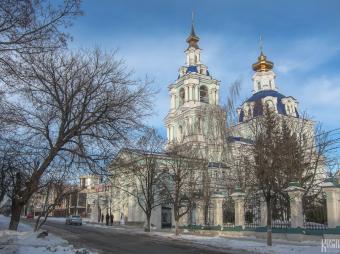
St Sergius of Radonezh and Our Lady of Kazan Icon Eparchial Cathedral
- 27 Ulitsa Gorkogo
- http://www.ser-kaz-sob.orthodoxy.ru
One of the most beautiful buildings in Kursk is the St Sergius of Radonezh and Our Lady of Kazan Icon Eparchial Cathedral. It was built between 1752 and 1778 and is a perfect example of Elizabethan baroque. In 1833 Kursk became the main city of its eparchy and this cathedral became the eparchial cathedral. In 1837 a grand bell tower in the empire style was added to the front of the church. The cathedral was closed in 1934 and briefly used as an art gallery and anti-religious museum… Read more »
Trinity Church
- 30 Ulitsa Gaidara
The Trinity Monastery, which was founded on the orders of Boris Godunov in 1597, once stood where the Trinity Church now stands. The church itself dates from 1742 and comprises a two-storey octagon-on-cube building with an attached bell tower. The monastery of which it was a part was dissolved in 1764. In 1940 the church was closed and used as a museum. It was returned to the Orthodox Church in the 1990s. Read more »
Trinity Convent
- 13/1 Ulitsa Gorkogo
- http://kursk-sestry.ru
The Trinity Convent was first mentioned in 1631, but most of its buildings were rebuilt in the 19th century. It was closed in the 1920s and briefly used as a prison and then for housing. In 1993 the territory was returned to the Orthodox Church which re-established the convent in 2004. The convent's only cathedral is the two-storey Trinity Cathedral which dates from 1695 but has been subject to reconstruction work several times since. Read more »
North of the City
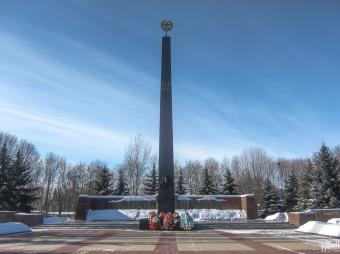
Memorial Complex to the Fallen of the Great Patriotic War
- Ploschad Geroev Kurskoy Bitvy, Ulitsa Karla Marksa
In 1984 the Memorial Complex to the Fallen of the Great Patriotic War was opened. Located next to Nikitskoe Cemetery, the complex serves as a military cemetery for soldiers who died during the Second World War, many unidentified and buried in mass graves. The war dead are remembered in many memorials at the complex including monumental gates, an obelisk, statues of soldiers and an eternal flame. Also included is a monument to the Kursk Nuclear Submarine which sank in the Barents… Read more »
St Nicetas' Church
- 48 Ulitsa Karla Marksa (Nikitskoe Cemetery)
St Nicetas' Church, which is also dedicated to the Dormition of Virgin Mary, was built in 1846 in the Russian-Byzantine style, based on a plan by the famous architect Konstantin Ton. It was built on the site of an older wooden church in a cemetery, now the city's Niktiskoe Cemetery. In 1939 the church was closed and used as a warehouse, its domes and crosses were removed in the process. However it was reopened in 1941 and remained open ever since. Read more »
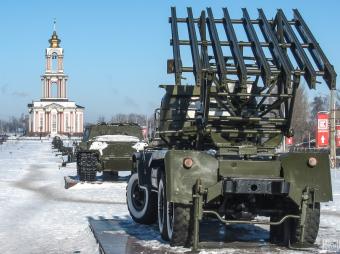
Victory Memorial Complex
- between Prospekt Pobedy and Ulitsa Karla Marksa
On the boulevard between Prospekt Pobedy (Victory Prospect) and Ulitsa Karla Marksa (Karl Marx Street), near the northern road into the city, is a memorial complex dedicated to victory in the Battle of the Kursk Salient. It was opened in 1998 to mark the 55th anniversary of the battle. Included in the complex are military equipment of the era, an eternal flame and the tomb of an unknown soldier. St George’s Church Also included in the complex is St George’s Church, which was… Read more »

 History
History